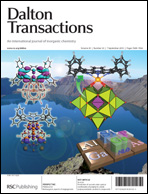|
Dalton Transactions
Dalton Transactions is a weekly peer-reviewed scientific journal covering original (primary) research and review articles on all aspects of the chemistry of inorganic, bioinorganic, and organometallic compounds. It is published by the Royal Society of Chemistry and the editor-in-chief is Russell Morris (University of St Andrews). The journal was named after the English chemist, John Dalton, best known for his work on modern atomic theory. The journal was named a "rising star" in 2006.[1] Publication historyThe journal was established as the Journal of the Chemical Society A: Inorganic, Physical, Theoretical in 1966. In 1972, the journal was divided into three separate journals: Journal of the Chemical Society, Dalton Transactions (covering inorganic and organometallic chemistry), Journal of the Chemical Society, Faraday Transactions 1: Physical Chemistry in Condensed Phases, and Journal of the Chemical Society, Faraday Transactions 2: Molecular and Chemical Physics. The journal obtained its current name in 2003. In January 2000, Acta Chemica Scandinavica was absorbed.[2] The Journal of the Chemical Society, Dalton Transactions was published as 12 issues a year from 1972. As submissions increased, the journal switched to 24 issues a year in 1992[3] and then to 48 issues a year in 2006.[4] In 2010, the journal introduced a sequential volume numbering scheme, with one volume per year. While volume numbers were not assigned retro-actively, the first issue of 2010 was assigned volume 39 (2010 being the 39th year since the establishment of the Journal of the Chemical Society, Dalton Transactions.[5] Abstracting and indexingThe journal is abstracted and indexed in: According to the Journal Citation Reports, the journal has a 2023 impact factor of 3.5.[13] Notable articlesAccording to the Web of Science, the following three articles have been cited most often:[14]
Dalton DiscussionsDalton Discussions are scientific meetings that provide a forum for the exchange of views and newly acquired results in focused areas of inorganic chemistry. The papers, which are associated with the oral presentations at the meeting, are published in a special issue of the journal, which constitutes a permanent record of the meeting. The meetings are usually held annually.[15] See alsoReferences
External links |
||||||||||||||||||||||||||||||||||||||||
